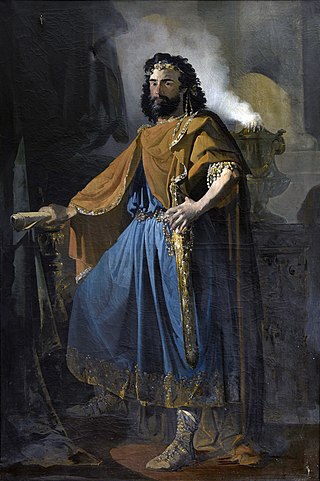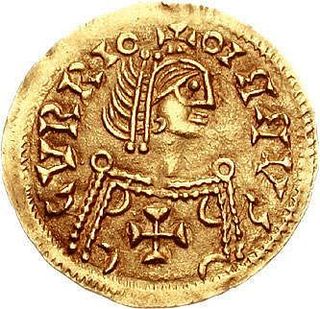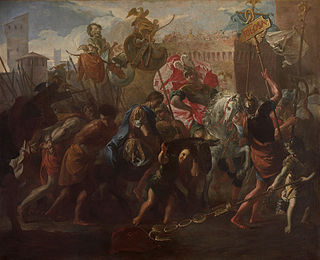Sources
- Jaques, Tony (2007). Dictionary of Battles and Sieges: P-Z. Greenwood Publishing Group. ISBN 978-0313335396.
| Battle of Toulouse | |||||||
|---|---|---|---|---|---|---|---|
| |||||||
| Belligerents | |||||||
| Visigoths | Western Roman Empire | ||||||
| Commanders and leaders | |||||||
| Theodoric I | Litorius † | ||||||
| Strength | |||||||
| Unknown | Unknown | ||||||
| Casualties and losses | |||||||
| Unknown | Unknown | ||||||
The Battle of Toulouse was fought between the Visigoths and the Western Roman Empire in 439. Having previously defeated the Visigoths at Narbonne, the Roman general Litorius led his largely Hunnic army against Toulouse, the capital of the Visigothic Kingdom. During the siege, the Visigothic king Theodoric I attacked the Roman camp and inflicted heavy casualties. Litorius was captured and executed. Since the Visigoths also suffered heavy losses, Theodoric made peace with the Roman governor Avitus.

Alaric II was the King of the Visigoths from 484 until 507. He succeeded his father Euric as king of the Visigoths in Toulouse on 28 December 484; he was the great-grandson of the more famous Alaric I, who sacked Rome in 410. He established his capital at Aire-sur-l'Adour in Aquitaine. His dominions included not only the majority of Hispania but also Gallia Aquitania and the greater part of an as-yet undivided Gallia Narbonensis.

The Visigoths were a Germanic people united under the rule of a king and living within the Roman Empire during late antiquity. The Visigoths first appeared in the Balkans, as a Roman-allied barbarian military group united under the command of Alaric I. Their exact origins are believed to have been diverse but they probably included many descendants of the Thervingi who had moved into the Roman Empire beginning in 376 and had played a major role in defeating the Romans at the Battle of Adrianople in 378. Relations between the Romans and Alaric's Visigoths varied, with the two groups making treaties when convenient, and warring with one another when not. Under Alaric, the Visigoths invaded Italy and sacked Rome in August 410.

Year 451 (CDLI) was a common year starting on Monday of the Julian calendar. At the time, it was known as the Year of the Consulship of Marcianus and Adelfius. The denomination 451 for this year has been used since the early medieval period, when the Anno Domini calendar era became the prevalent method in Europe for naming years.

Year 439 (CDXXXIX) was a common year starting on Sunday of the Julian calendar. At the time, it was known as the Year of the Consulship of Theodosius and Festus. The denomination 439 for this year has been used since the early medieval period, when the Anno Domini calendar era became the prevalent method in Europe for naming years.

Euric, also known as Evaric, son of Theodoric I, ruled as king (rex) of the Visigoths, after murdering his brother, Theodoric II, from 466 until his death in 484. Sometimes he is called Euric II.

Septimania is a historical region in modern-day southern France. It referred to the western part of the Roman province of Gallia Narbonensis that passed to the control of the Visigoths in 462, when Septimania was ceded to their king, Theodoric II. During the Early Middle Ages, the region was variously known as Gallia Narbonensis, Gallia, or Narbonensis. The territory of Septimania roughly corresponds with the modern French former administrative region of Languedoc-Roussillon that merged into the new administrative region of Occitanie. In the Visigothic Kingdom, which became centred on Toledo by the end of the reign of Leovigild, Septimania was both an administrative province of the central royal government and an ecclesiastical province whose metropolitan was the Archbishop of Narbonne. Originally, the Goths may have maintained their hold on the Albigeois, but if so it was conquered by the time of Chilperic I. There is archaeological evidence that some enclaves of Visigothic population remained in Frankish Gaul, near the Septimanian border, after 507.

The Battle of Vouillé was fought in the northern marches of Visigothic territory, at Vouillé, near Poitiers (Gaul), around Spring 507 between the Franks, commanded by Clovis, and the Visigoths, commanded by Alaric II. The Franks' victory resulted in their conquest of Gallia Aquitania and the death of Alaric II.
The siege of Narbonne was a conflict between the Visigothic Foederati of Aquitania and the Western Roman Empire.

Rechiar or Flavius Rechiarius was the third Suevic king of Gallaecia, from 448 until his death, and also the first one to be born in Gallaecia. He was one of the most innovative and belligerent of the Suevi monarchs. Hydatius, the contemporary bishop and chronicler from Galicia who is the sole contemporary source for biographical details of Rechiar, established his reputation as that of a barbarian with little sense of Roman law, culture, or custom; accusations already discredited, but very common at that time.
Septimania was the western region of the Roman province of Gallia Narbonensis that passed under the control of the Visigoths in 462. It passed briefly to the Emirate of Córdoba in the eighth century before its reconquest by the Franks, who by the end of the ninth century termed it Gothia. This article presents a timeline of its history.

The Visigothic Kingdom, Visigothic Spain or Kingdom of the Goths occupied what is now southwestern France and the Iberian Peninsula from the 5th to the 8th centuries. One of the Germanic successor states to the Western Roman Empire, it was originally created by the settlement of the Visigoths under King Wallia in the province of Gallia Aquitania in southwest Gaul by the Roman government and then extended by conquest over all of Hispania. The Kingdom maintained independence from the Eastern Roman or Byzantine Empire, whose attempts to re-establish Roman authority in Hispania were only partially successful and short-lived.

Theodoric I was the King of the Visigoths from 418 to 451. Theodoric is famous for his part in stopping Attila the Hun at the Battle of the Catalaunian Plains in 451, where he was killed.
The Battle of Arelate was fought in 458 near Arelate (Arles) between Western Roman Emperor Majorian and Visigothic king Theodoric II. After the assassination of Flavius Aetius in 454, the Visigoths began to expand their kingdom at the expense of the crumbling Roman administration in Gaul and Hispania. When Majorian became emperor in 457, the Visigoths under king Theodoric II had just recently defeated the Suebic Kingdom in north-west Hispania and were consolidating their hold on the rest of the peninsula.

Litorius was a Roman general of the closing period of the Western Roman Empire serving as Magister militum per Gallias mainly in Gaul under magister militum Flavius Aetius. Litorius is noted for being the last Roman commander in the ancient Roman military history to perform pagan rites and the consultation of auspices before a battle.
The Battle of Arles was fought between the Visigoths and a Roman-Hunnic alliance in 425. The Visigoths and the Romans had previously been in peace, but in 425 the Visigothic king Theodoric I broke the peace treaty and invaded Gaul, laying siege to Arles. He was defeated and driven away by the Romans, under the leadership of Flavius Aetius, and their Hunnic allies. Theodoric thereafter made peace again, instead turning his sights on the Vandals in Hispania.
The Battle of Arles was fought between the Visigoths and the Western Roman Empire in 435. The Visigoths and the Romans had previously been in peace after having fought each other at Arles in 425, but in 435 the Visigothic king Theodoric I again broke the peace treaty and invaded Gaul, laying siege to Arles once more. He was however defeated and driven away by the Romans under the leadership of Flavius Aetius and his largely Hunnic army. Two years later, Theodoric was defeated at a decisive battle at Narbonne.
The Battle of Toulouse was fought in the Gothic War between the Visigoths and the Western Roman Empire in 458. The battle was part of a great mid-winter expedition made across the alps by Emperor Majorian, taking a large army from Italy into Gaul with the goal of restoring the region to Roman rule after the disastrous reign of Avitus. Majorian and the Visigothic king Theodoric II fought a battle at Toulouse, in which the Visigoths were defeated. Majorian thereafter secured the cooperation of the Visigoths against the Suebi in Spain. However, fighting resumed, and Theodoric was finally defeated at Orléans in 463.

The Gothic War (436–439) was a military conflict between the Gothic foederati and the Western Roman Empire under Emperor Valentinian III. It occurred primarily in the Gallic provinces from 436 to 439. The key figures involved were the Gothic leader Theodoric I and the Roman army's commander-in-chief, Aetius. Contemporary sources characterize this conflict as a war. Additionally, there were uprisings of the Burgundians and the Bagaudae during the same period.

The Gothic War in Spain of 456 was a military operation of the Visigoths commissioned by the West Roman emperor Avitus. This operation consisted of an extensive campaign aimed at reclaiming the Spanish provinces of Lusitania and Betica that were in the hands of the Suebi and threatened Roman power in the provinces of Cartaginensis and Tarraconensis. The main players in this war were Theoderic II who led the army of the Visigoths and Rechiar the king of the Suebi. The Visigothic army was supported by Franks and Burgundian auxiliary troops.

The Gothic War of 457-458 was a military conflict between the Visigoths of Theoderic II against the Western Roman Empire of Emperor Majorian. The war began in 457 with a revolt of the Goths in Aquitania that pushed aside Roman authority, followed by an aggressive conquest in the adjacent Septimania aimed at area expansion. The war ended with a Roman victory over the Goths in the Battle of Arles in 458.